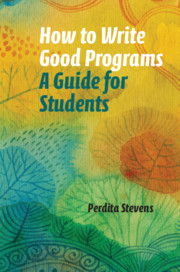Book contents
- Frontmatter
- Contents
- 1 Introduction
- 2 What Are Good Programs?
- 3 How to Get Started
- 4 How to Understand Your Language
- 5 How to Use the Best Tools
- 6 How to Make Sure You Don’t Lose Your Program
- 7 How to Test Your Program
- 8 How to Make Your Program Clear
- 9 How to Debug Your Program
- 10 How to Improve Your Program
- 11 How to Get Help (without Cheating)
- 12 How to Score Well in Coursework
- 13 How to Score Well in a Programming Exam
- 14 How to Choose a Programming Language
- 15 How to Go Beyond This Book
- Bibliography
- Index
- Frontmatter
- Contents
- 1 Introduction
- 2 What Are Good Programs?
- 3 How to Get Started
- 4 How to Understand Your Language
- 5 How to Use the Best Tools
- 6 How to Make Sure You Don’t Lose Your Program
- 7 How to Test Your Program
- 8 How to Make Your Program Clear
- 9 How to Debug Your Program
- 10 How to Improve Your Program
- 11 How to Get Help (without Cheating)
- 12 How to Score Well in Coursework
- 13 How to Score Well in a Programming Exam
- 14 How to Choose a Programming Language
- 15 How to Go Beyond This Book
- Bibliography
- Index
Summary
This chapter addresses how you can approach an early programming exercise. What do you need to know, and to have available, before you can start? How can you make some progress, even if you do not immediately know how to complete the exercise? What should you do if you get confused?
Information
- Type
- Chapter
- Information
- How to Write Good ProgramsA Guide for Students, pp. 12 - 32Publisher: Cambridge University PressPrint publication year: 2020
Accessibility standard: Unknown
- 1
- Cited by
